Even if you’re not looking to spend Gibson money, there’s still a way to get an authentic Les Paul, and not just a LP style guitar, and that’s by opting for one of the best Epiphone Les Pauls – and we’d highly suggest checking out the Epiphone Les Paul Standard ’60s. From a distance, you’d never be able to spot the difference between this or a Gibson Standard, and that’s down to the incredible attention to detail that has gone into this guitar. Like any good Les Paul, it features a solid mahogany body and beautiful flame maple top with a set mahogany neck, and a pair of PAF style humbuckers. The pickups themselves are Epiphone ProBuckers, which have been voiced to sound just like the original Gibson pickups being used in the ‘60s, and they sound incredible. It’s loaded with quality hardware, including Grover tuners, and when you consider how close the specs are to the Gibson equivalent, it’s no wonder we gave this our best Epiphone Les Pauls Top Pick award.
If you’re OK to up the budget a little, you could opt for one of the best Epiphone Les Pauls ever built, the Epiphone Slash Les Paul Standard. This model is built to Slash’s specifications, including everything from the pickups to the neck profile, so it absolutely stands out from the regular Standard models. It comes in a range of finishes made famous by the GNR guitarist, and to really make it unique, it features his famous Skully character as a headstock decal. It’s a jump up in price, yes, but it does also come with a fitted hard case, again, with the Skully branding, and as for component upgrades, it comes with Orange drop capacitors and CTS potentiometers, just like a Gibson. Even if you’re not a Slash fan, the Epiphone Slash Les Paul Standard is a simply phenomenal guitar, and well worth the money – we love it so much we’ve named it as our best Epiphone Les Pauls Editor’s Choice.
If you’re trying not to spend too much, but you still want a great Epiphone Les Paul, check out the Epiphone Les Paul Special. It’s about as simple as a Les Paul can get with its slim, slab body, and vintage style satin finish. It’s fitted with one of Epiphone’s most playable necks, the ‘60s SlimTaper D, which makes it both extremely comfortable and forgiving. It has simpler electronics than most Les Paul models, with its single volume and single tone control for adjusting the pair of humbucking pickups, something that really increases the appeal with newer players. It’s one of the most affordably priced Les Pauls on the market, which when combined with the fantastic playability and performance, makes it the obvious choice for our best Epiphone Les Pauls Best Budget award.
Read more about our review process.
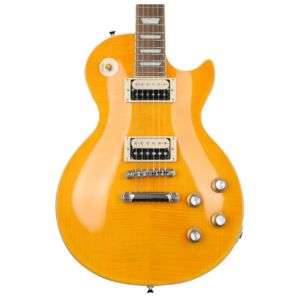
Epiphone Slash Les Paul Standard
Features: AAA Flamed top, CTS Pots, Probucker pickups
Benefits: Stunning looks, Ultra smooth volume/tone sweep, Huge Les Paul tones
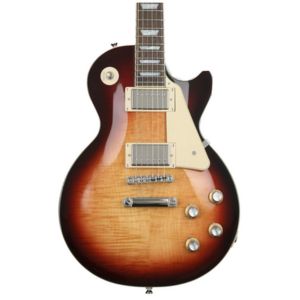
Epiphone Les Paul Standard '60s
Features: SlimTaper neck, AA Flamed top, CTS Electronics
Benefits: Classic look and feel, Fast playing, Consistent tone
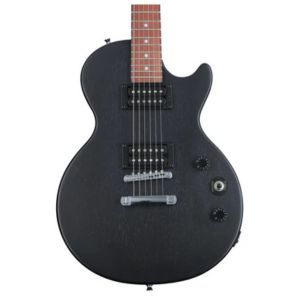
Epiphone Les Paul Special
Features: Rosewood fretboard, Lightweight body, 2 Humbucking pickups
Benefits: Great feel, Comfortable to hold, Real Les Paul tones
Contents
Individual Reviews
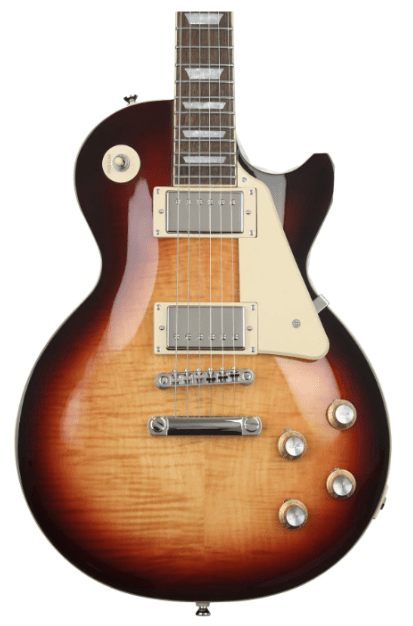
Epiphone Les Paul Standard ‘60s
Awesome looks, huge tones, and professional level performance.
This Fantastic Epiphone Les Paul is perfect for those looking for the real Les Paul experience, but don’t have the funds to stretch to a US made version. It uses high end components, and delivers big on playability.
The Standard ’60s was an absolute joy to play and nets you quality and feel similar to a real Gibson Standard at a fraction of the price.
It featured a SlimTaper ’60s C profile set neck made from solid mahogany (just as it should be). The shape of the neck made it one of the most comfortable of any LP in this test group. As an added bonus, it was a lightning-fast player. The fretboard was made from Indian laurel, which admittedly can be quite hit or miss, but in this case it was just right.
Being a Standard model, the neck was bound, but as it’s not a Gibson, you won’t see the nibbed fret ends that you would on the Gibson Les Paul Standard ’60s. Regardless, we found the finish of the frets to be particularly well done. The edges were well-beveled and flush with the fretboard edges, and the crowns had a decent polish, so there was no feeling of grittiness.
Our test guitar weighed in at 9lb 3oz; enough to feel like a real Les Paul, but not so much that you never want to pick it up. The body was made in the classic LP style, with solid mahogany and a maple cap. In our case, the maple cap had stunning AA flame figuring.
It was loaded with Epiphone Probucker alnico humbuckers, which sounded really good across the board. The neck was pretty hot, but we still managed to get some nice warmth out of it with the right settings. This guitar really screamed in the bridge position, giving us incredible overdriven tones with high gain and superb clean tones with the gain rolled back.
Verdict: The Standard ’60s is all the guitar the average player will ever need. It’s forgiving enough for novice players, while offering the performance that working musicians need. There’s no reason this couldn’t go out gigging and it can more than hold its own in a recording studio. It gave us all the classic tones and considering it’s around ¼ the price of a Gibson Standard ’60s, it’s well worth taking a look at if you’re not looking to spend too much.
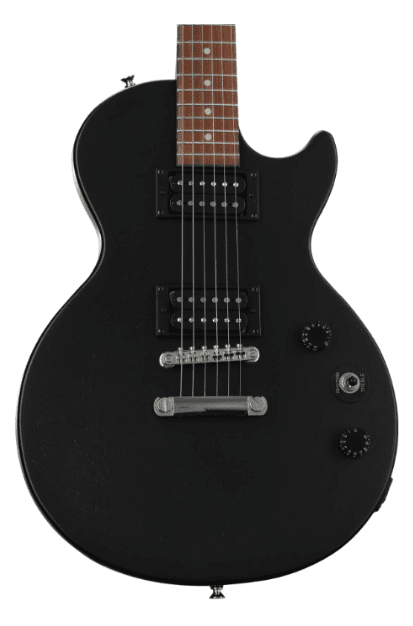
Epiphone Les Paul Special
A genuine Les Paul for a lot less money than you might expect.
This is the Les Paul to go for if your budget is tight. You get the looks and the humbucker tones, as well as the superb Epiphone quality that you’d expect. This entry level guitar draws on the heritage of this model, and even incorporates some of the key features all for a bargain price.
The LP Special was one of the biggest surprises of the test. It delivered big on quality and playability, which are undoubtedly the most important factors for the target market this guitar is aimed at.
The neck had a ’60s SlimTaper D profile, which is one of Epiphone’s slimmest designs. We found it to be incredibly comfortable. Even younger or smaller players will have no issues with the size of the neck. While the neck isn’t set like a true Les Paul, this helps out with durability, especially for novice players who might not be so well versed in how to handle a guitar.
The fretwork was another pleasant surprise, with no sharp edges to be found, further adding to the already excellent comfort. Interestingly, it was fitted with a genuine rosewood fretboard, which is normally considered to be a more premium wood than Indian laurel. As expected, it looked and felt great.
Breaking from tradition, the LP Special had a poplar body, but we found that this provided a significant weight reduction, which again adds to the appeal for younger or smaller players who might not be able to handle a 10lb+ Les Paul Standard.
It had a pair of humbuckers, with a 650R in the neck and a 700T in the bridge. They gave us a great range of tones, with decent cleans, some rich tones in the neck position, and the bridge pickup even managed to get a little rowdy when pushed hard.
Verdict: The LP Special is one of the cheapest ways to get your hands on a real Les Paul. It’s squarely aimed at novice players and as such, it’s a very forgiving guitar. It offers everything you need to learn the basics, and should you decide that the Les Paul platform is the one for you, you can always upgrade to one of Epiphone’s other fantastic LP models.
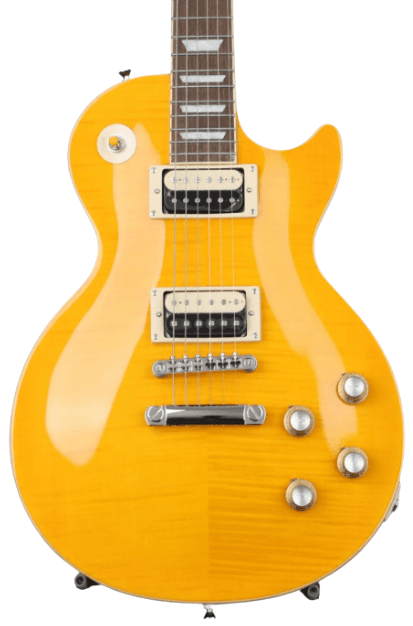
Epiphone Les Paul Slash Standard
Serious performance with a real appetite for destruction.
Slash fans looking to get their hands on a real signature model without spending thousands need look no further. This model is a faithful replica of the guitar used by Slash in the AFD era, and it might just be the best Epiphone Les Paul on the market today.
The Slash Les Paul Standard is Epiphone’s take on the signature model of the behatted guitar legend. It offers unbelievable build quality and feel, and might have you rethinking buying a Gibson Les Paul Tribute.
Immediately after picking it up, we realized it wasn’t just another Les Paul with Slash branding. From top to bottom, it’s designed to his specs. Starting with the neck, which has a Slash Custom C profile. It’s noticeably beefier than their SlimTaper profiles, but still a bit slimmer than a ’50s-style neck. The result was a ridiculously playable neck that really encouraged serious fretboard exploration.
On the topic of the fretboard, it had the same Indian Laurel board as our top pick, the Standard ’60s. Again, it was smooth, and felt good under the fingers. We had no issues with it, although for the price, a rosewood upgrade might have been nice. The fretwork was superb, with highly polished crowns and brilliantly finished edges.
One of the biggest draws to this signature model is the finish. Our test model came in Appetite Burst, which is arguably Slash’s most recognizable look. The AAA flamed maple top looked incredible from any angle and was beautifully accented by the red mahogany on the rear of the body.
The pickups were also exclusive to the model. In this case, they were Custom Probuckers. They gave us a range of authentic vintage PAF tones, and when we ran it through a Marshall JCM model on the Katana, they truly came to life. Everything was crisp and clear, with incredible depth and superb responsiveness. It was wired with premium CTS pots and even orange drop capacitors, making this a real tool guitar for those looking to get maximum performance for their money.
Verdict: For only marginally less than a Gibson Les Paul Tribute, you can have the Slash Les Paul Standard, which undoubtedly has a much nicer finish and feel. It may seem expensive for an Epiphone, but trust us, this is a cut above anything you’ll find at lower levels in their lineup. It rocks hard and the included hard case is the icing on the cake.
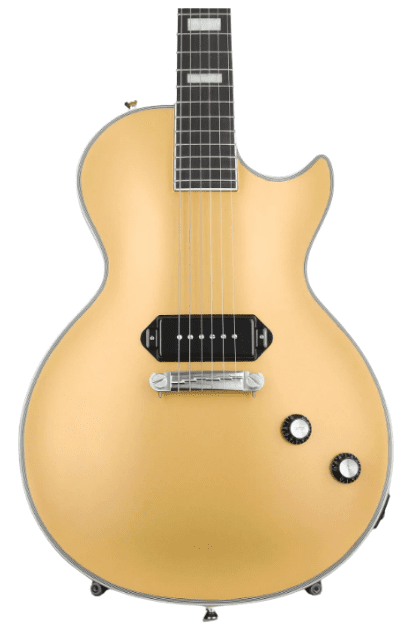
Epiphone Jared James Nichols Gold Glory Les Paul Custom
Possibly the most unique looking Les Paul in the lineup.
If you love the Les Paul body shape, but you like to keep your tones simple, this Custom model might be the one for you. It’s a signature model sporting a single P90, giving it a truly unique look. It offers screaming P90 tones, and high end build quality, making it perfect for the discerning blues player.
The Jared James Nichols Gold Glory Les Paul Custom is another of Epiphone’s fantastic signature models, and it was a popular option amongst the KGR staff.
JJN is a big fan of chunky necks, which is why the Gold Glory comes with a mahogany ’50s Rounded C profile. This is one of the biggest necks Epiphone offers and has a real baseball bat feel. If you like chunky necks, you’ll adore this, but if you have smaller hands or you’re used to playing something similar, the neck is apt to be a dealbreaker for you.
It had a luxurious ebony fretboard that set off the gold beautifully. The fretwork was fantastic and very much on par with our Editor’s Choice winner, the Slash signature. We found that everything was really nicely finished, properly leveled, and superbly set up right out of the box.
Being a custom model, it came with all of the typical accouterments you’d expect, including a bound body, neck, and headstock, as well as Grover tuners. It had the usual mahogany body with a maple cap and was finished in a classic Double Gold. The absence of a neck pickup gave it a very clean look. Normally, single-pickup Les Pauls are slab bodies, not carved tops like this, so it really stood out.
The pickup is a bridge-mounted Seymour Duncan Dog Ear P90. It gave the Gold Glory a significantly different tone than a PAF-equipped LP, and it did a phenomenal job with everything from clean blues to screaming overdriven rock. It had a single volume and a single tone control, which in combination with the high output pickup, gave us all the tones we could ask for.
Verdict: The Jared James Nichols Gold Glory Les Paul Custom might have one of the longest names of any Les Paul in history, but the guitar itself is simplicity defined. Classic LP construction and a screaming P90 are always going to be a recipe for success. Its enormous neck profile means it’s not the most universally comfortable guitar, but if fat necks are your thing, you’ll love it.
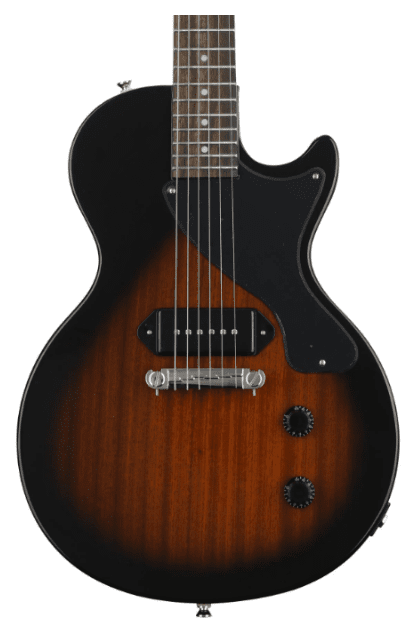
Epiphone Les Paul Junior
The original student grade guitar.
Since its relaunch as part of the “Inspired by Gibson” range, this Les Paul has been a huge best seller for Epiphone. With almost identical specs to the US made original, but at a far more affordable price, it delivers huge performance and is highly attainable.
The LP Junior is a clone of the Gibson Les Paul Junior, which was once their cheapest model, designed for students and beginners who couldn’t afford their more substantial Standard models (or the later Studio models). However, thanks to its affordability and surprising versatility, it became an icon of the punk scene (and our favorite cheap Les Paul).
Like the Gold Glory Custom, the Les Paul Junior gets a ’50s C profile neck, which is baseball-bat-like, to put it mildly. The lighter weight of the junior does seem to make the neck width a little more tolerable, however. Of course, the neck is set and made from mahogany. So, despite the girth, it still plays well.
It had a solid mahogany body, but in this case, being a slab-style model, it had no maple cap. Tobacco Burst is the only available color, but we really loved the look. If other options were available, we’d likely have picked this color anyway.
The fretboard was Indian laurel, just as we found on several of the other models. It felt good and played nicely, but on this particular guitar, it didn’t have the prettiest grain pattern. In fact, it looked a bit patchy. This didn’t affect playability at all, but it was all the more noticeable after playing with a high-end ebony fretboard.
This is another Les Paul with a single P90 pickup, but in this case, an Epiphone model. When we cranked it, it gave us some really angry, growling tones, making it easy to see why this guitar has become such a punk icon. With the tone and volume rolled back a little way, it warmed up and gave us some rich blues tones, although it did lose some clarity, especially in comparison with the Seymour Duncan pickup on the Gold Glory.
Verdict: The LP Junior is a solid choice for players of all levels. Its simple design means it still suits its original purpose as a beginner instrument, but the complex tones and excellent build quality also mean it works well for gigging guitarists.

Epiphone Les Paul Classic
Classic looks with modern playability.
If you love the look of older Les Pauls but find yourself a little put off by vintage style playability, this might be a great choice for you. It features coil splitting and phase switching, for an extended tonal palate, and it offers all the feel you want from a quality Les Paul.
The Epi Les Paul Classic is, at least at a glance, a typical late ’50s-style Les Paul reproduction. But in fact, Epiphone has made some modifications to make this more user-friendly for less experienced players and those who prefer modern playability.
Take the neck. ’50s Les Pauls are notorious for their enormous, thick necks, but Epiphone fitted the Classic with a SlimTaper profile, making it comfortable for almost every player. The neck is set of course, and made from solid mahogany. It also featured an Indian laurel fretboard and had nicely finished fretwork.
It had classic Les Paul construction, featuring a solid mahogany body with the obligatory maple cap, which produced the expected sustain and resonance that we’ve come to love with carved-top Les Pauls. Even though it’s technically not a Standard, it’s equipped similarly and includes binding on the upper part of the body and on the neck. It also came fitted with a pickguard.
This was a well-appointed guitar and included high-end hardware, including genuine Grover Rotomatic tuners, which cleaned up the look quite a lot.
The pickups on the Classic were a pair of Alnico Classic PRO humbuckers. They weren’t bad by any stretch but were very much outshone by those in the ProBuckers in the Standard ’60s. The Alnico Classic Pros were, as advertised, extremely hot, which led to them sounding a little brash and thin at times. They did feature coil-splitting, which was a nice touch. The coil-splitting unlocked single-coil tones, which are usually not found on Les Paul models, were excellent, so of course, this versatility was excellent.
Verdict: The Epip Les Paul Classic is a great option for players who love the vintage look, but who want a slim, fast-playing neck and modern features like coil-splitting pickups. It’s as well made as any other Epi Les Paul, and more than suitable for players of all levels.
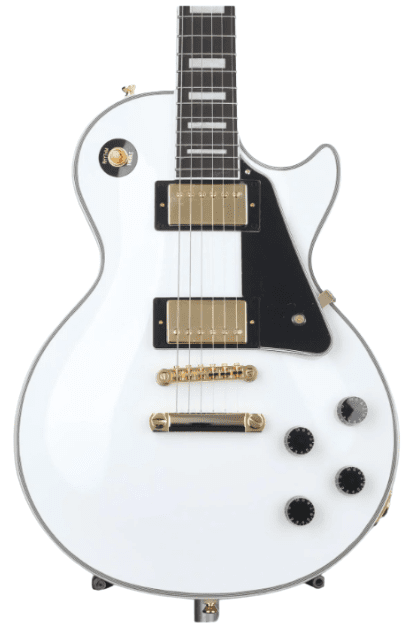
Epiphone Les Paul Custom
The flagship Les Paul at a much more palatable price.
The Les Paul Custom is the flagship model in the lineup, and for good reason. It gets the best of everything, from hardware and electronics, to trim and construction. These models may feature timeless looks, but they absolutely pack the performance to back those looks up.
The Epiphone LP Custom is a stunning looking guitar, with high-end appointments that more than justify the additional cost over the Standard models and Epiphone’s other entry-level guitars.
The SlimTaper neck was a treat to play. It was the same profile found on several of the other models we reviewed in this roundup, and we really couldn’t get enough of it. We found that it was fast and offered excellent ergonomics from top to bottom.
It had an ebony fretboard, which as we found with the Gold Glory Custom, looked incredible. Not only were the looks a huge draw, but it felt smooth and tactile under the fingers. We couldn’t find any fault with it whatsoever.
Another point of appreciation came from the fretwork, which was once again finished incredibly well. Short of being PLEKd like the Gibson equivalent would be, we’re not sure the fretwork could have felt much better.
The finish is always the big attention grabber with custom models. We tried out the Alpine White, which is such a great color on these guitars. Of course, it’s also available in ebony. It had binding on the top and bottom of the body, on the neck, and on the headstock, and against the white finish, it really stood out.
Hardware was all finished in gold, which first of all, isn’t everybody’s cup of tea. More importantly, the gold hardware on Epiphone models has a tendency to pit and fade away quite quickly. This might not be so bad, but because the body has a polyester finish, it will always look brand new while the hardware ages.
It had a pair of ProBucker 2 pickups, which delivered a great range of tones from glassy cleans, which were perfect for jazz all the way to guttural metal chugging. Of course, in between, it manages to hit the classic vintage PAF tones, too.
Verdict: If you’re into the tuxedo look, the Epiphone LP Custom is the only way to go. It does look sensational, although if gold hardware isn’t your thing, you’d be better off looking at another model. The fit and finish is superb on the custom. When you combine that with the versatile tones, you have a pro-level guitar at a very intermediate price.
How to Choose The Right Les Paul For You
If you’re in the market for an Epi Les Paul, the names used between models can really make it difficult to decipher exactly what you’re looking at. Keep on reading to find out all you need to know about choosing the right Epi LP.
Body Style
Slab
Slab-style bodies are completely flat and have no contours outside of the guitar’s natural shape. The top and back of the guitar’s body are completely flat, too, hence the slab moniker. Slab guitars are generally cheaper to produce, which results in a more affordable guitar.
Carved Top
The Les Paul does come in many forms, but the most widely known is the carved top. When a Les Paul has a carved top, it typically has a mahogany slab body with a carved maple cap stuck to the top. The maple adds brightness and snappiness to the guitar’s tone, but also adds a significant amount of extra weight.
Neck Profile
Epiphone’s range of Les Pauls come in an array of different neck profiles. Truthfully, no one profile is “better” than another, as this is an element that is purely about personal preference.
Thinner Necks like the SlimTaper D, SlimTaper C, and plain SlimTaper tend to be faster, and usually more comfortable, especially for newer players.
Thick necks like the ’50s profile are typically favored by more experienced players looking to get maximum feel and sustain from the guitar. The additional mass of a heavier, thicker neck can help to keep a guitar ringing out for longer.
Pickups
On any electric guitar, the biggest impact on the overall sound comes from its electronics and, most noticeably, the pickups. Epi LPs are available with a couple of different pickup styles, including:
P90
P90 pickups were a Gibson invention and are actually a type of single-coil pickup. While by definition, they’re more closely related to a Strat than a PAF Les Paul, these P90 pickups are renowned for their ability to growl when introduced to high gain.
Humbuckers
The PAF, or Patent Applied For, humbuckers used in the majority of Epi LPs offer a huge range of tones. They’re most famous, however, for their thick, heavy tones that helped to define the rock genre in the late ’50s and ’60s, even into today. These are double-coil pickups that were designed to cancel out the humming noise that can be experienced with the use of single-coils pickups, P90 included.
Final Thoughts
Epiphone’s swing at the classic Gibson Les Paul is a great way for almost any guitarist to get their hands on a true workhorse guitar that will, for the most part, be a lifelong companion. They come in almost all the same configurations as their Gibson counterparts and are made to exacting standards in Gibson’s privately-owned overseas plants. So you can be assured that you’re getting a quality product, despite the fact they aren’t made in the USA.
To recap our findings, the Epiphone Les Paul Standard ’60s was our Top Pick, offering a great blend of performance and value. Those on the tightest budgets will most likely enjoy the Epiphone Les Paul Special, our Best Budget pick. If you’re considering a high-end Epiphone, we’d suggest our Editor’s Choice, the Epiphone Slash Standard.


